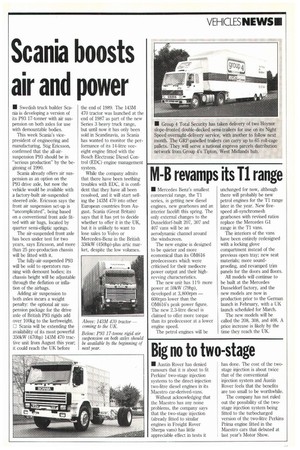Scania boosts air and power
Page 13

If you've noticed an error in this article please click here to report it so we can fix it.
• Swedish truck builder Scania is developing a version of its P93 17-tonner with air suspension on both axles for use with demountable bodies.
This week Scania's vicepresident of engineering and manufacturing, Stig Ericsson, confirmed that the all-airsuspension P93 should be in "serious production" by the beginning of 1990.
Scania already offers air suspension as an option on the P93 drive axle, but now the vehicle would be available with a factory-built air-suspended steered axle. Ericsson says the front air suspension set-up is "uncomplicated", being based on a conventional front axle fitted with air bags, located by quarter semi-elliptic springs.
The air-suspended front axle has been under test for two years, says Ericsson, and more than 25 pre-production chassis will be fitted with it.
The fully-air-suspended P93 will be sold to operators running with demount bodies; its chassis height will be adjustable through the deflation or inflation of the airbags.
Adding air suspension to both axles incurs a weight penalty: the optional air suspension package for the drive axle of British P93 rigids add over 100kg to the kerbweight. LI Scania will be extending the availability of its most powerful 350kW (470hp) 143M 470 tractive unit from August this year; it could reach the UK before
the end of 1989. The 143M 470 tractor was launched at the end of 1987 as part of the new Series 3 heavy truck range, but until now it has only been sold in Scandinavia, as Scania has wanted to monitor the performance of its 14-litre veeeight engine fitted with the Bosch Electronic Diesel Control (EDC) engine management system.
While the company admits that there have been teething troubles with EDC, it is confident that they have all been resolved, and it will start selling the 143M 470 into other European countries from August. Scania (Great Britain) says that it has yet to decide whether to offer it in the UK, but it is unlikely to want to lose sales to Volvo or Mercedes-Benz in the British 336kW (450hp)-plus artic market, despite the low volumes.
































































































